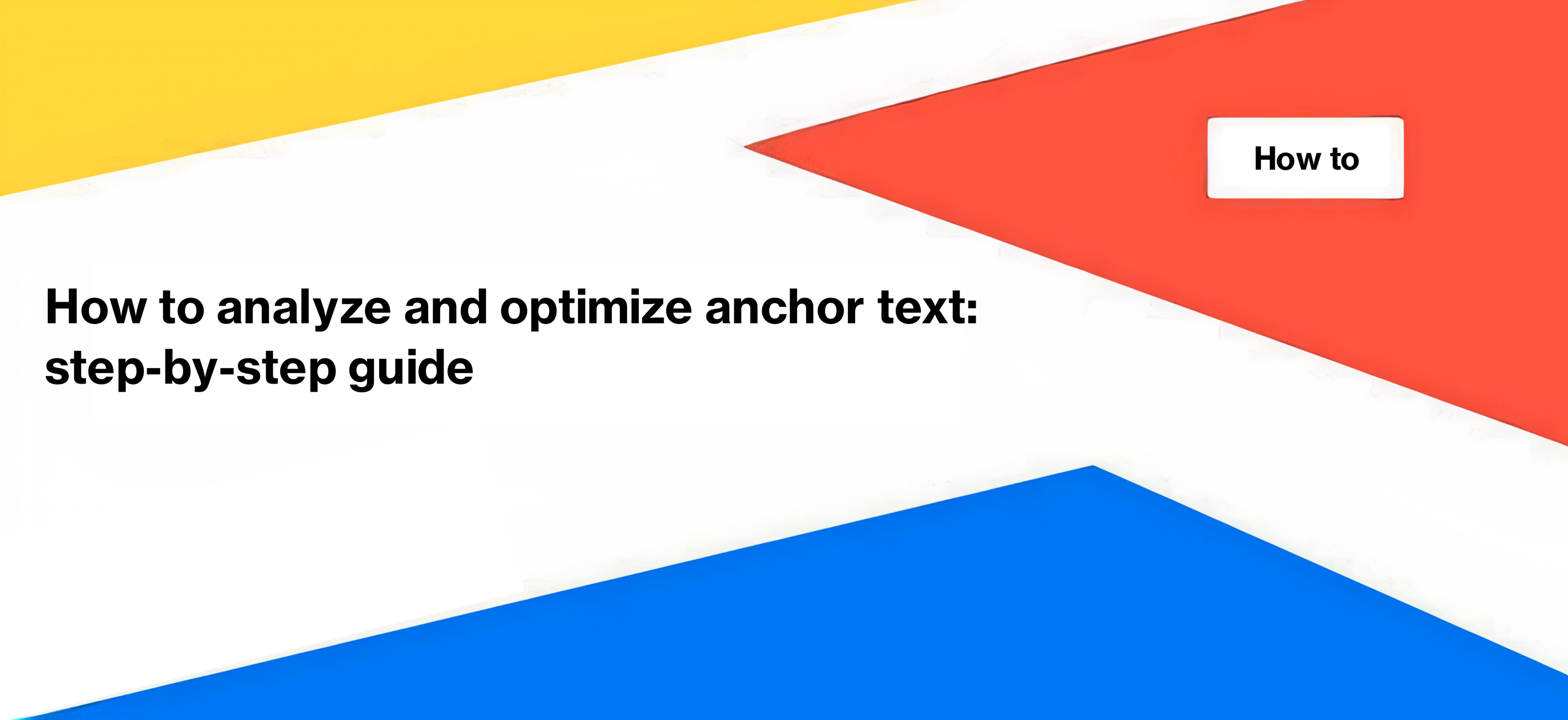
How to analyze and optimize anchor text: step-by-step guide
In this article, we will tell you how to analyze anchor texts and how to make the most of them to optimize your website. We believe that you should not underestimate anchor texts and always pay attention to this part if you want to get maximum results in SEO.
What are anchor texts and why are they important?
Anchor text is the visible part of a hyperlink. Users see this text and understand where they click.
For search engines, anchor texts are also crucial because they help search bots understand where the link points to. Such associations aid bots in better comprehending the purpose and content of the link.
Clear and correct anchors are important for the accessibility of your website as well. Suspicious, identical, or incomplete anchors make your website less accessible and user-friendly.
On the site, most anchors are displayed as follows:

In the HTML code of the page, the anchor text is displayed as follows:
<a href=”https://google.com”>Google documentation</a>
The link itself will be invisible to the user but users will see “Google documentation” text.
Why do you need to analyze anchors?
As you can see, anchors are important for both users and search bots. They have a significant impact on your SEO. By using keywords as anchors, you can start ranking for those keywords. However, keep in mind that anchors alone are not enough to reach the top. Nonetheless, a variety of anchors will help Google associate the page with those keywords, thereby increasing the visibility of your website. In other words, anchors serve as context signals for search engines.
What should the text anchors be?
First and foremost, anchors should be clear and natural. The primary task of anchors is to let users understand where they will click. For this reason, you should avoid using unnatural occurrences of keywords, as they can appear as spam.
Anchors should also be varied, as this helps expand the context for understanding the page. For example, you can create several anchors based on long-tail keywords. However, remember that all anchors must be relevant. There should be no surprises for users. If you use the anchor “apple,” the user should land on a page about apples, not pears, after clicking the link. Irrelevant anchors can negatively affect your website’s ranking, as they signal to search bots that you have pears on your apple page. This can reduce the visibility of the pear page since it will not be the only page about pears on your website. Similarly, the apple page may have a higher bounce rate because some users will be searching for pears based on the anchor.
There is another often overlooked recommendation from Google concerning anchors. If the link opens in a new tab (target=”_blank” is used), it is worth specifying in the anchor that the page will open in a new tab.
How to analyze anchors?
Using JetOctopus, you can analyze anchors to understand their impact on SEO and identify areas for improvement.
Data on all anchors are available in the “Links” report.
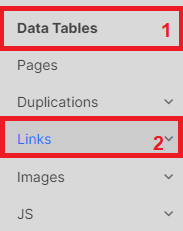
We recommend conducting a full website crawl to obtain complete information about all anchors on your website. If the crawl is incomplete, you may not find all outlinks and anchors.
Next, you can perform several different checks.
Detect empty anchors
Empty anchors provide no context to users or search engines, except when the previous sentence provides the context for where the anchor is leading. To find empty anchors, go to the “Links” datatable. Then, click the “+Add filter” button and select “Anchor” – “Is empty”. Apply the filter.
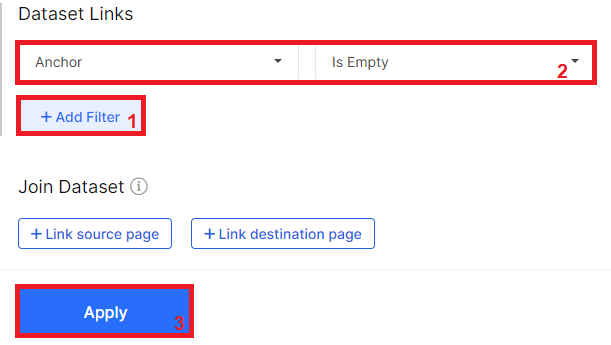
As a result, you will get a list of links that have empty anchors.
Find duplicates (identical anchors for different pages)
To ensure that context signals are not confusing, you need to use different anchors for different pages. As mentioned before, consider the example with apples. To check for duplicated anchors, go to the “Links” datatable, click “+Add filter,” and select “Anchor” – “Contains” or “Equals.” Enter the desired anchor.

The resulting data table will have three main columns: “Page URL” (the page where the link with the anchor is placed), “Link destination (absolute URL)” (the page to which the link points), and “Anchor” (the anchor of the link from the “Link destination (absolute URL)” column).

Make sure that the “Link destination (absolute URL)” matches for anchors with the same context. You can also assess the overall uniqueness of your anchors by going to the “Internal Links” – “Texts Analysis” dashboard.
Then observe the “Unique Anchors” chart.
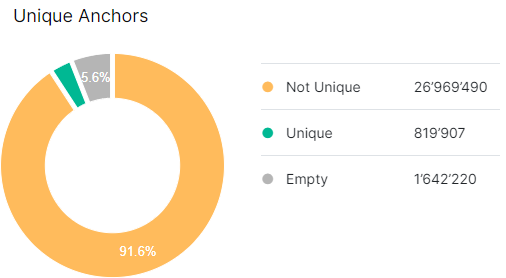
Identify too short anchors
Anchors that are too short can confuse users, so it is important to identify and analyze them. If necessary, replace them. To find short anchors, go to the “Internal Links” – “Texts Analysis” dashboard. Scroll down to the “Anchors Words” chart.
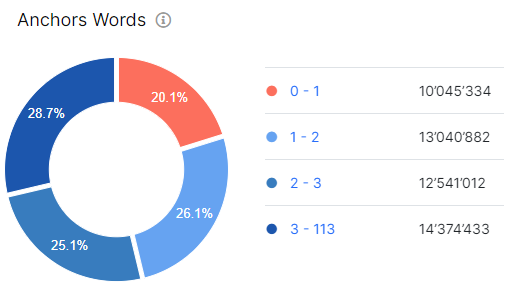
Click on the segments to access the data table. Start by analyzing anchors with 1 word and choose the ones that make the most sense for replacement.
You can also analyze anchors with a small number of symbols, which may provide insights for you. Click the “+Add filter” button in the “Links” data table, select “Anchor length” – “Less,” and enter the desired number. Start by analyzing anchors that are less than 5 characters long.

Identify too long anchors
Anchors that are excessively long can be misleading, so it is worthwhile to analyze such anchors. To do this, in the “Links” datatable, select the “Anchor Words Count” – “> Greater” – “10” filter.

Analyze abnormally long anchors and replace those that are incorrect or do not provide any useful context. Because sometimes it happens that instead of one or two words, a whole sentence is mistakenly used as the anchor.
Check for special characters in anchors
Sometimes anchors contain symbols, which can be errors. These symbols can include commas, <, >, slashes, and more. To detect such anchors, in the “Links” datatable, select the “Anchor” – “Contains” filter, and enter the desired symbol.

Optimizing anchor texts is a crucial aspect of website optimization and SEO. By ensuring clear, relevant, and varied anchors, you can enhance the user experience, improve search engine visibility, and ultimately drive more organic traffic to your website. Don’t underestimate the power of anchor texts in maximizing your online presence and achieving better SEO results. You can use JetOctopus SEO crawler for analyzing and optimizing anchor texts.

